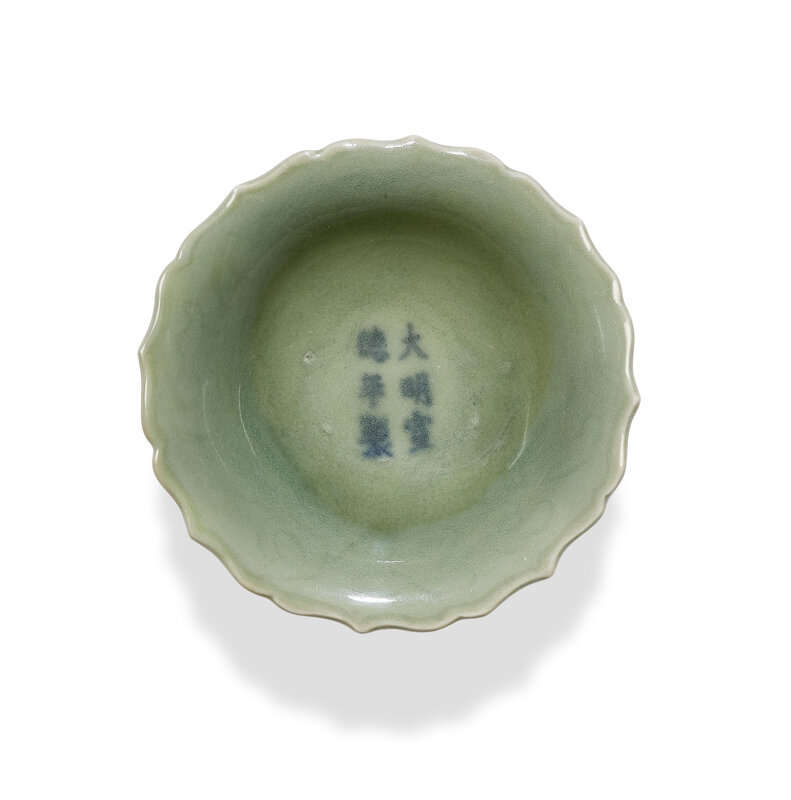A small celadon-glazed incised dish, Xuande six-character mark and of the period (1426-1435)
Lot 152. A small celadon-glazed incised dish, Xuande six-character mark and of the period (1426-1435); 8.5cm (3 3/8in) diam. Estimate HK$ 100,000-150,000. Sold for HK$ 140,000. Photo: Bonhams.
The finely-potted shallow sides rising from a tapered wedge-shaped foot to a flared barbed rim, faintly incised to the interior with stylised lingzhi scrolls encircling a six-character reign mark in underglaze blue, applied overall with a thick celadon glaze of sea-green tone, save for the unglazed footring fired to buff-orange, box.
Note: During the early Ming period the Longquan kilns appear to have worked closely with the Imperial kilns at Jingdezhen making wares of similar form and decoration, perhaps under Imperial instruction. The Imperial kiln adopted Longquan celadon and transformed it into a new type of green glaze, dongqing (wintergreen), a more subtle tone of green during the Yongle and Xuande periods. Small dongqing-glazed dishes produced in the Xuande period were treasured during the late Ming period, leading to copies being made; see a small Xuande-marked celadon-glazed dish in the Beijing Palace Museum, dated to Wanli, illustrated in The Complete Collection of the Treasures of the Palace Museum-Monochrome Porcelain, Hong Kong, 1999, p.139, no.126.
During the early Ming period the Longquan kilns appear to have worked closely with the Imperial kilns at Jingdezhen making wares of similar form and decoration, perhaps under Imperial instruction. The Imperial kiln adopted Longquan celadon and transformed it into a new type of green glaze, dongqing (wintergreen), a more subtle tone of green during the Yongle and Xuande periods. Small dongqing-glazed dishes produced in the Xuande period were treasured during the late Ming period, leading to copies being made; see a small Xuande-marked celadon-glazed dish in the Beijing Palace Museum, dated to Wanli, illustrated in The Complete Collection of the Treasures of the Palace Museum-Monochrome Porcelain, Hong Kong, 1999, p.139, no.126.
Compare with a similar small celadon-glazed dish, Xuande six-character mark and of the period, which was sold at Sotheby's Hong Kong, 8 October 2019, lot 3613.
From the Collection of Edward T. Chow (1910-1980). A small incised celadon-glazed dish, Mark and period of Xuande (1426-1435); 8.8 cm, 3 1/2 in. Estimate 150,000 — 200,000 HKD (19,112 - 25,482 USD). Lot Sold 200,000 HKD (25,466 USD) at Sotheby's Hong Kong, 8 October 2019, lot 3613. Courtesy Sotheby's.
Cf. my post: A small incised celadon-glazed dish, Mark and period of Xuande (1426-1435)
Bonhams. Fine Chinese Cerics and Works of Art, 1 Dec 2020, Hong Kong, Admiralty

/https%3A%2F%2Fprofilepics.canalblog.com%2Fprofilepics%2F1%2F0%2F100183.jpg)
/https%3A%2F%2Fstorage.canalblog.com%2F03%2F02%2F119589%2F96711876_o.jpg)
/https%3A%2F%2Fstorage.canalblog.com%2F11%2F31%2F119589%2F94773502_o.jpg)
/https%3A%2F%2Fstorage.canalblog.com%2F20%2F83%2F119589%2F94772815_o.jpg)
/https%3A%2F%2Fstorage.canalblog.com%2F26%2F72%2F119589%2F75604929_o.jpg)
/https%3A%2F%2Fstorage.canalblog.com%2F59%2F60%2F119589%2F26458628_o.jpg)




/image%2F1371349%2F20240402%2Fob_7227e1_129-1.jpg)
/image%2F1371349%2F20240329%2Fob_2076ee_113-1.jpg)
/http%3A%2F%2Fstorage.canalblog.com%2F92%2F58%2F119589%2F129772574_o.jpg)
/http%3A%2F%2Fstorage.canalblog.com%2F50%2F04%2F119589%2F129632031_o.jpg)